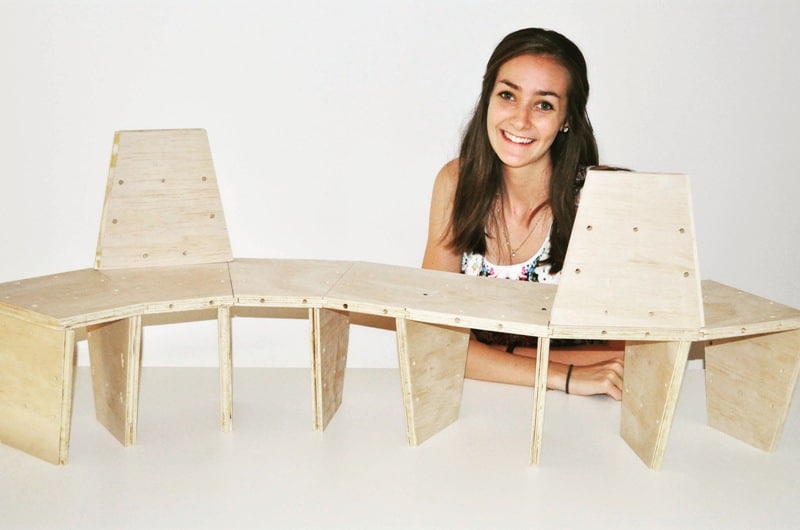Over the period 16th to 19th July 2015 the Australian International Furniture Fair in partnership with Décor and Design held an event at Melbourne’s Exhibition Center showcasing 250 companies with their new and innovative furniture products. Each year the exhibition stages the VIVID (Vibrant Vision in Design) competition aimed at displaying Australia’s leading lighting and furniture designers and their products. The designers that were involved in VIVID competition were labelled as “the boldest and brightest young Australian designers”.
One of TKO’s interior designers, Emily Neville, was a finalist in the VIVID competition and she travelled to Melbourne to present her design. Emily’s piece, called “Shift”, is a modular design made with timber pieces connected via metal rods. Shift is well designed and engineered with precise penetrations and grooves facilitating the creation of customised casual dining space configurations.
Amongst the 90 VIVID finalists there was a strong trend towards the use of natural materials including timber, cork, concrete and powder coated metals. Handmade and hand crafted techniques were also highlighted in many of the pieces in conjunction with new technologies such as 3D printing. Most of the pieces reflected a high degree of innovation resulting in both functionality and flexibility.
VIVID presents 4 awards for “Excellence in Design” each year. The winning designs for 2015 were:
 1) “WINE STOOL” by Gabriella Aliwarga from RMIT University in Victoria.
1) “WINE STOOL” by Gabriella Aliwarga from RMIT University in Victoria.
This piece was inspired by the relationship between the cork and the wine bottle. It was constructed from reclaimed maple wood and powder coated steel with no screws or glue. The wooden tops are turned by hand and divided into two parts, allowing it to clamp the steel frame and secure it.
 2) “COUNTERPOINT LIGHT” by Peter Milligan from the Central Institute of Technology in WA.
2) “COUNTERPOINT LIGHT” by Peter Milligan from the Central Institute of Technology in WA.
This piece was designed as the perfect home office desk lamp with an adjustable angle allowing it to be easily altered to suit the task required. The piece was made from coloured laminates, unglazed ceramic, carbon fibre and 3D printed plastic.
 3) “AGAVE CREDENZA” by Richard Greenacre from RMIT University in Victoria.
3) “AGAVE CREDENZA” by Richard Greenacre from RMIT University in Victoria.
Inspired by the sculptural leaves of the Agave plant, the 3D textured pattern on the façade of this credenza were made from a hand cast acrylic resin composite to create an interesting juxtaposition between the doors and the timber frame of the piece.
 4) “REIDING PENDANT” by Alexandra Reid from Sydney TAFE Design Centre Enmore in NSW.
4) “REIDING PENDANT” by Alexandra Reid from Sydney TAFE Design Centre Enmore in NSW.
Constructed of tightly compressed pages and held together with steel, the form was created through a carving and sanding process. A hollow area was then made in the base of the pendant to allow space for the globe; this also allowed a glimpse of the compressed pages with the text subtly peering through the layers.
This exhibition was a great opportunity for Emily to meet a range of industry professionals, gain inspiration from other designers and to explore the diversity of design throughout the industry. Emily is now working on a new project with the aim of exhibiting again next year and the possibility of incorporating some of these innovations into client fitout designs.

